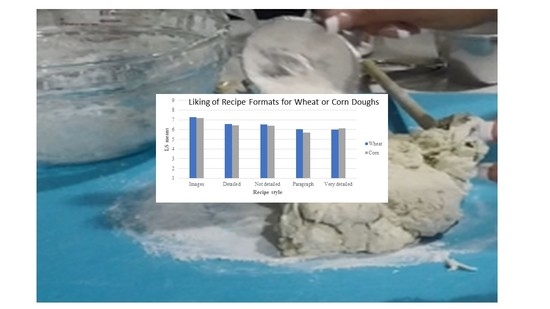Development and Validation of a Recipe Method for Doughs
Abstract
1. Introduction
2. Materials and Methods
2.1. Qualitative Study
2.1.1. Subjects’ Recruiting
2.1.2. Participants’ Demographics
2.1.3. Dough Preparation Sessions
2.2. Post Session Interview
2.3. Moderators
2.4. Recipes Validation
- Not detailed recipe: same as the one given to experienced consumers during the dough preparation sessions; written in a step-by-step format.
- Detailed recipe: recipe that included details, but not as many as the very detailed recipe. This recipe was written in a step-by-step format.
- Very detailed recipe: recipe that included a complete and exhaustive description of the preparation of the dough and the ready dough; written in a step-by-step format.
- Paragraph-form; based on the detailed recipe, the process was described in paragraphs.
- Images; also based on the detailed recipe. The process was written using pictures taken from the dough preparation sessions and some captions to describe each of the steps.
2.4.1. Online Survey
2.4.2. Respondents
2.5. Data Analysis
2.5.1. Qualitative Study: Dough Preparation Sessions
2.5.2. Recipe Validation: Online Survey
3. Results and Discussion
3.1. Preparation Process
3.1.1. Measurement of Ingredients
3.1.2. Measurement of Ingredients
3.1.3. Description of a “Ready Dough”
3.2. Recipe Validation
Cluster Analysis
3.3. Practical Applications
3.4. Limitations
4. Conclusions
Author Contributions
Funding
Acknowledgments
Conflicts of Interest
Appendix A
Appendix A.1. Wheat Recipes
Appendix A.1.1. Not Detailed, Step by Step Format
- Wash your hands with warm water and soap for at least 20 s.
- 3 cups of all purpose wheat flour
- 2 cups of warm water
- 1.5 teaspoon of salt
- 1 packet of instant dry yeast
- 2 tablespoons of vegetable oil
- Mix the dry ingredients: yeast, salt and 2/3 of the flour in a bowl.
- Then, add the oil (if required, as needed), and half of the water.
- Use a wooden spoon to stir the mix, add the other half of water as needed.
- Continue stirring with the wooden spoon. When it is ready, turn the dough onto a floured board to knead.
- Add the rest of the flour as needed.
- Put the ball of dough in a clean bowl and cover it with plastic wrap.
- Let the dough rise for 30 min to an hour, until it doubles in size.
- Grease a loaf pan.
- Shape the dough into a rectangle about the size of the loaf pan.
- Put the dough in the pan.
- Preheat the oven to 425 °F (or 215 °C)
- Let the dough rest another 30 min to an hour, before baking it.
- Bake the dough 25–30 min until it is golden brown.
- Let it cool down for at least 30 min.
- Remove from the pan.
Appendix A.1.2. Very Detailed, Step by Step Format
- Wash your hands with warm water and soap for at least 20 s.
- 1 big bowl
- 1 wooden spoon
- Dry ingredients measuring cups
- Wet ingredients measuring cups
- Thermometer
- Loaf pan
- 3 cups of all purpose wheat flour split into two
- 1.5 cups of flour for the initial mixing
- 1.5 cups of flour to add as needed during mixing and kneading
- 2 cups of warm water (110 °F/43 °C)
- 1.5 teaspoon of salt
- 1 packet of instant dry yeast (7 g)
- 2 tablespoons of vegetable oil
- In a large bowl add the following ingredients:
- 1.5 cups of flour
- 1.5 tsp of salt
- 1 packet of instant dry yeast
- Use a wooden spoon:
- Mix using circular motions, scraping the mix from the sides towards the center.
- Mix until all the dry ingredients are evenly distributed, use the yeast as a guide since it is a different color.
- Make a well in the center of the dry ingredients.
- Add 3/4 cup of the water into the well.
- Add the oil into the well.
- Stir the wet and dry ingredients together using the wooden spoon
- As the dough begins to form, fold the dough into itself as you scrape the mix from the sides to the center incorporating all the ingredients together.
- Press the dough down to break any lumps.
- Look at your dough after mixing it:
- If it looks dry and there is loose flour, add water, 1 tablespoon at a time and continue mixing.
- If it looks too sticky and there is too much water that is not being incorporated, add 1/4 of a cup of flour and continue mixing.
- Your dough will be ready when the mixing gets harder and you have one lump-free ball that is sticky, but you can still handle with your hands. The dough should pull away from the sides of the bowl with no liquid left in the bowl and no loose flour.
- On your kneading surface (either a cutting board or a counter top), spread ¼ cup of flour, creating a thin layer. Use this flour to cover your hands as well.
- Scrape the dough out of the bowl onto the floured surface.
- Start kneading it:
- Using your hands, roll the dough back and forth over the floured surface, covering it all with flour.
- With the heels of your hands, push the dough down spreading it away from you, then fold the dough in half and turn it in a quarter turn.
- Repeat step b 3 times.
- If the dough is still sticky, roll it again on the flour that is left on your kneading surface; if you already used all the flour, add another tablespoon of it on the surface, repeat steps a and c.
- Continue steps a to d until the dough is no longer sticky.
- Once the dough is not sticky, repeat step b until you get a smooth and elastic ball of dough so that when you touch it with one of your fingers, it springs back.
- Form the dough into a ball.
- Put the ball of dough in a clean bowl and cover it with plastic wrap.
- Let the dough rise for 30 min to an hour, until it doubles in size.
- Grease a loaf pan.
- Shape the dough into a rectangle about the size of the loaf pan.
- Put the dough in the pan.
- Preheat the oven to 425°F (or 215 °C).
- Let the dough rest another 30 min to an hour, before baking it.
- Bake the dough 25–30 min until it is golden brown.
- Let it cool down for at least 30 min.
- Remove from the pan.
Appendix A.1.3. Detailed, Step by Step
- Wash your hands with warm water and soap for at least 20 s.
- 1 big bowl
- 1 wooden spoon
- Dry ingredients measuring cups
- Wet ingredients measuring cups
- Thermometer
- Loaf pan
- 3 cups of all purpose wheat flour
- 2 cups of warm water (110°F/43°C)
- 1.5 teaspoon of salt
- 1 packet of instant dry yeast (7 g)
- 2 tablespoons of vegetable oil
- In a large bowl add 1.5 cups of flour, 1.5 tsp of salt and 1 packet of instant dry yeast.
- Use a wooden spoon to mix the ingredients, until all they are evenly distributed.
- Add 3/4 cup of the water and the oil, stir using the wooden spoon.
- If the dough looks dry and there is loose flour, mix in 1 tablespoon of water.
- If there is water not incorporated, mix in ¼ cup of flour.
- Your dough will be ready when you have one lump-free ball that is sticky, but you can still handle with your hands.
- Spread flour on your kneading surface, apply it on your hands and on the surface of the dough.
- Scrape the dough out of the bowl onto the floured surface.
- With the heels of your hands, push the dough down, then fold it in half and turn it in a quarter turn; repeat 3 times.
- If the dough is still sticky, add another tablespoon and continue kneading until it is not sticky.
- Once the dough is not sticky, continue kneading until you get a smooth and elastic ball of dough.
- Put the ball of dough in a clean bowl and cover it with plastic wrap.
- Let the dough rise for 30 min to an hour, until it doubles in size.
- Grease a loaf pan.
- Shape the dough into a rectangle about the size of the loaf pan.
- Put the dough in the pan.
- Preheat the oven to 425 °F (or 215 °C)
- Let the dough rest another 30 min to an hour, before baking it.
- Bake the dough 25–30 min until it is golden brown.
- Let it cool down for at least 30 min.
- Remove from the pan.
Appendix A.1.4. Detailed, Paragraph Format
- Wash your hands with warm water and soap for at least 20 s.
- Put the ball of dough in a clean bowl and cover it with plastic wrap.
- Let the dough rise for 30 min to an hour, until it doubles in size.
- Grease a loaf pan.
- Shape the dough into a rectangle about the size of the loaf pan.
- Put the dough in the pan.
- Preheat the oven to 425 °F (or 215 °C).
- Let the dough rest another 30 min to an hour, before baking it.
- Bake the dough 25–30 min until it is golden brown.
- Let it cool down for at least 30 min.
- Remove from the pan.
Appendix A.1.5. Detailed, Image Format
- Wash your hands with warm water and soap for at least 20 s.
- 1 big bowl
- 1 wooden spoon
- Dry ingredients measuring cups
- Wet ingredients measuring cups
- Thermometer
- Loaf pan
- 3 cups of all purpose wheat flour
- 2 cups of warm water (110 °F/43 °C)
- 1.5 teaspoon of salt
- 1 packet of instant dry yeast (7 g)
- 2 tablespoons of vegetable oil
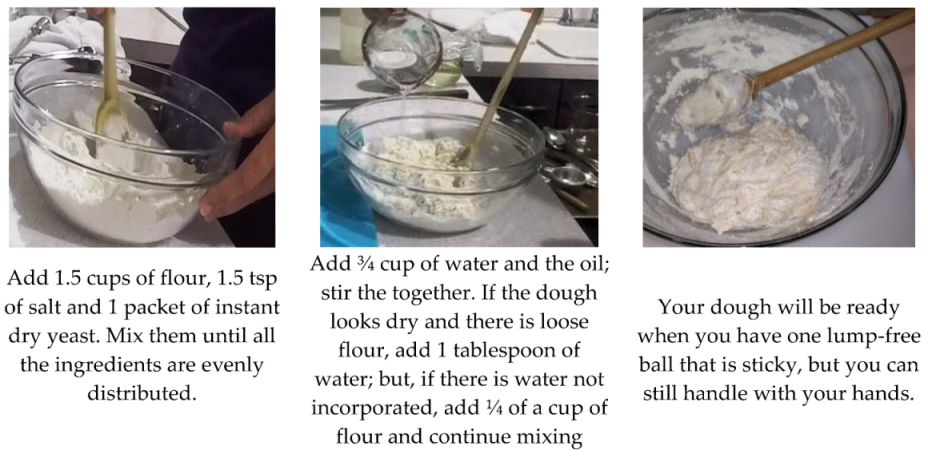

- Put the ball of dough in a clean bowl and cover it with plastic wrap.
- Let the dough rise for 30 min to an hour, until it doubles in size.
- Grease a loaf pan.
- Shape the dough into a rectangle about the size of the loaf pan.
- Put the dough in the pan.
- Preheat the oven to 425 °F (or 215 °C).
- Let the dough rest another 30 min to an hour, before baking it.
- Bake the dough 25–30 min until it is golden brown.
- Let it cool down for at least 30 min.
- Remove from the pan.
Appendix A.2. Corn Recipes
Appendix A.2.1. Not Detailed, Step by Step Format
- Wash your hands with warm water and soap for at least 20 s.
- 1.5 cups of corn flour
- 1 cup of warm water (110 °F/43 °C)
- 1 teaspoon of salt
- Mix the 1 cup of flour and 0.5 teaspoons of salt.
- Add water a little bit at a time until your dough ready.
- Add the rest of the flour, salt and water as needed.
- Preheat the skillet (medium heat).
- Divide the dough into 3 equal-size balls.
- Cut a plastic bag along the sides and put it in the tortilla press.
- Put a ball of dough in the middle of the plastic bag in the press.
- Flattened the tortilla using the tortilla press.
- Peel the tortilla away from the plastic.
- Place the tortilla in the skillet and let it cook for 1 min.
- Turn the tortilla over and let it cook on the other side for another minute.
- Wrap the tortilla in a warm towel to keep it warm.
Appendix A.2.2. Very Detailed, Step by Step Format
- Wash your hands with warm water and soap for at least 20 s.
- 1 big bowl
- Dry ingredients measuring cups
- Wet ingredients measuring cups
- Measuring spoons
- Thermometer
- A skillet
- A tortilla press
- A zip plastic bag
- 1.5 cups of corn flour split into two
- 1 cup of flour for the initial mixing.
- 1/2 cups of flour to add if needed.
- 1 cup of warm water (110 °F/43 °C)
- 1 teaspoon of salt (you will add 1/2 tsp at a time)
- In a large bowl add the following ingredients:
- 1 cup of flour
- ½ tsp of salt
- ½ cups of water
- Use your hands to mix all the ingredients together:
- Start with a circular movement as you dissolve the flour in the water.
- If the dough is not forming into a ball and It looks lumpy, dry, and there is loose flour, add a tablespoon of water and continue with step 2.
- Once everything is coming together into one ball, do one circular motion around the bowl picking up all the flour or dough stuck to the sides of the bowl, then mash the dough against the bowl using your hand.
- Repeat step 3 until the dough forms one ball that does not stick to the bowl.
- Take a piece of the dough and make one small ball about the size of an egg.
- Flatten the ball between your hands, if:
- The dough sticks to your hands, add another teaspoon of flour and repeat steps 2 to 4.
- The dough breaks down into pieces or cracks in the middle, add another teaspoon of water and repeat steps 2 to 4 (it is ok if there are small cracks on the edges).
- Try the taste of the dough, is this the amount of salt you like in your tortillas? If not, add another ½ teaspoon of salt and mix it again as in steps 2 and 3.
- Your dough is ready when it does not stick to the bowl or your hands and is soft, lump-free, and workable.
- Preheat the skillet (medium heat).
- Divide the dough into 3 equal-size balls.
- Cut a plastic bag along the sides and put it in the tortilla press.
- Put a ball of dough in the middle of the plastic bag in the press.
- Flattened the tortilla using the tortilla press.
- Peel the tortilla away from the plastic.
- Place the tortilla in the skillet and let it cook for 1 min.
- Turn the tortilla over and let it cook on the other side for another minute.
- Wrap the tortilla in a warm towel to keep it warm.
Appendix A.2.3. Detailed, Step by Step
- Wash your hands with warm water and soap for at least 20 s.
- 1 big bowl
- Dry ingredients measuring cups
- Wet ingredients measuring cups
- Measuring spoons
- Thermometer
- A skillet
- A tortilla press
- A zip plastic bag
- 1.5 cups of corn flour
- 1 cup of warm water (110 °F/43 °C)
- 1 teaspoon of salt
- In a large bowl add: 1 cup of flour, 1/2 tsp of salt and 1/2 cup of water.
- Mix all the ingredients together using your hands.
- If the dough is not forming into a ball and it looks lumpy and dry, add a tablespoon of water and continue mixing.
- Once everything is coming together into one ball, pick up all the flour or dough stuck to the sides of the bowl and mash the dough against the bowl using your hand. Continue doing this until the dough is no longer sticky.
- Take a piece of the dough and flatten it between your hands, if the dough sticks to your hands, add another teaspoon of flour and continue mixing; but, if the dough breaks down into pieces, add another teaspoon of water and continue mixing.
- Try the dough, if it is needed, add more salt and mix.
- Your dough is ready when it does not stick to the bowl or your hands, it is lump-free and workable.
- Preheat the skillet (medium heat).
- Divide the dough into 3 equal-size balls.
- Cut a plastic bag along the sides and put it in the tortilla press.
- Put a ball of dough in the middle of the plastic bag in the press.
- Flattened the tortilla using the tortilla press.
- Peel the tortilla away from the plastic.
- Place the tortilla in the skillet and let it cook for 1 min.
- Turn the tortilla over and let it cook on the other side for another minute.
- Wrap the tortilla in a warm towel to keep it warm.
Appendix A.2.4. Detailed, Paragraph Format
- Wash your hands with warm water and soap for at least 20 s.
- Preheat the skillet (medium heat).
- Divide the dough into 3 equal-size balls.
- Cut a plastic bag along the sides and put it in the tortilla press.
- Put a ball of dough in the middle of the plastic bag in the press.
- Flattened the tortilla using the tortilla press.
- Peel the tortilla away from the plastic.
- Place the tortilla in the skillet and let it cook for 1 min.
- Turn the tortilla over and let it cook on the other side for another minute.
- Wrap the tortilla in a warm towel to keep it warm.
Appendix A.2.5. Detailed, Image Format
- Wash your hands with warm water and soap for at least 20 s.
- 1 big bowl
- Dry ingredients measuring cups
- Wet ingredients measuring cups
- Measuring spoons
- Thermometer
- A skillet
- A tortilla press
- A zip plastic bag
- 1.5 cups of corn flour
- 1 cups of warm water (110 °F/43 °C)
- 1 teaspoon of salt

- Preheat the skillet (medium heat).
- Divide the dough into 3 equal-size balls.
- Cut a plastic bag along the sides and put it in the tortilla press.
- Put a ball of dough in the middle of the plastic bag in the press.
- Flattened the tortilla using the tortilla press.
- Peel the tortilla away from the plastic.
- Place the tortilla in the skillet and let it cook for 1 min.
- Turn the tortilla over and let it cook on the other side for another minute.
- Wrap the tortilla in a warm towel to keep it war.
Appendix B
| Variables | Likeability of Instructions | Format Helpfulness | Ease | Amount of Information | Likelihood to Use It |
|---|---|---|---|---|---|
| Likeability of instructions | 1 | 0.805 | 0.632 | −0.228 | 0.688 |
| Format helpfulness | 0.805 | 1 | 0.578 | −0.132 | 0.607 |
| Ease | 0.632 | 0.578 | 1 | −0.269 | 0.644 |
| Amount of information | −0.228 | −0.132 | −0.269 | 1 | −0.214 |
| Likelihood to use | 0.688 | 0.607 | 0.644 | −0.214 | 1 |
| Variables | Likeability of Instructions | Format Helpfulness | Ease | Amount of Information | Likelihood to Use It |
|---|---|---|---|---|---|
| Likeability of instructions | 1 | 0.768 | 0.656 | −0.100 | 0.728 |
| Format helpfulness | 0.768 | 1 | 0.539 | −0.040 | 0.595 |
| Ease | 0.656 | 0.539 | 1 | −0.211 | 0.664 |
| Amount of information | −0.100 | −0.040 | −0.211 | 1 | −0.093 |
| Likelihood to use it | 0.728 | 0.595 | 0.664 | −0.093 | 1 |
Appendix C
| Recipe | Cluster 1 (n = 169) | Cluster 2 (n = 131) |
|---|---|---|
| Images | 6.136A | 8.076A |
| Not detailed | 5.444 B | 7.145B |
| Detailed | 5.408B | 7.344BC |
| Paragraph | 4.994C | 6.985C |
| Very detailed | 4.385D | 6.908C |
| Recipe | Cluster 1 (n = 161) | Cluster 2 (n = 139) |
|---|---|---|
| Images | 5.957a | 7.978a |
| Not detailed | 5.329b | 7.043b |
| Detailed | 5.155b | 7.158b |
| Very detailed | 4.472c | 7.101b |
| Paragraph | 4.453c | 6.612c |
References
- Recipes Make a Comeback as U.S. Households Eat Meals at Home More, Reports NPD. Available online: https://www.npd.com/wps/portal/npd/us/news/press-releases/pr_120709/#.T_3FqPXz6Eo (accessed on 15 May 2018).
- Mintel. A New Generation of Cooking Enthusiasts Are Taking over in the Kitchen. Available online: http://www.mintel.com/press-centre/social-and-lifestyle/a-new-generation-of-cooking-enthusiasts-stirring-it-up-in-the-kitchen (accessed on 15 May 2018).
- Brunosson, A.; Brante, G.; Sepp, H.; Mattsson Sydner, Y. To use a recipe—Not a piece of cake. Students with mild intellectual disabilities’ use of recipes in home economics. Int. J. Consum. Stud. 2014, 38, 412–418. [Google Scholar] [CrossRef]
- Granberg, A.; Brante, G.; Olsson, V.; Sydner, Y.M. Knowing how to use and understand recipes: What arithmetical understanding is needed when students with mild intellectual disabilities use recipes in practical cooking lessons in home economics? Int. J. Consum. Stud. 2017, 41, 494–500. [Google Scholar] [CrossRef]
- Venturi, F.; Sanmartin, C.; Taglieri, I.; Nari, A.; Andrich, A.; Zinnai, A. Effect of the baking process on artisanal sourdough bread-making: A technological and sensory evaluation. Agrochimica 2016, 60, 222–234. [Google Scholar] [CrossRef]
- Levis, P.; Chambers, E.; Chambers, D.; Hollingsworth, M. Consumer use of package directions of varying formats for familiar and unfamiliar food products. In Creative Applications: Sensory Techniques Used in Conducting Packaging Research with Consumers; Gelinas, A., Ed.; ASTM International: West Conshohocken, PA, USA, 1996; pp. 16–24. [Google Scholar]
- Godwin, S.; Maughan, C.; Chambers, E. Food safety: Recommendations for determining doneness in consumer egg dish recipes and measurement of endpoint temperatures when recipes are followed. Foods 2016, 5, 45. [Google Scholar] [CrossRef] [PubMed]
- Maughan, C.; Godwin, S.; Chambers, D.; Chambers IV, E. Recipe modification improves food safety practices during cooking of poultry. J. Food Prot. 2016, 79, 1436–1439. [Google Scholar] [CrossRef] [PubMed]
- Landers, P. Recipe development project using commodity food products. J. Nutr. Educ. Behav. 2003, 35, 335–336. [Google Scholar] [CrossRef]
- Shapiro, S. Focus groups: The first step in package design. Mark. News 1990, 24, 15–17. [Google Scholar]
- Bielunski, M. Recipe format survey: What consumers really want in a recipe. Food Nutr. News 1994, 66, 6–7. [Google Scholar]
- Reed, D.B.; Schuster, E. Recipe checklist: A tool to aid development of recipes for audiences with limited resources. J. Ext. 2002, 40, 1–8. [Google Scholar]
- Bruun, A.; Stage, J. An Empirical Study of the Effects of Three Think-Aloud Protocols on Identification of Usability Problems; Aalborg University: Aalborg, Denmark, 2015. [Google Scholar]
- Morin, A.; Duhnych, C.; Racy, F. Self reported inner speech use in university students. Appl. Cogn. Psychol. 2018, 32, 376–382. [Google Scholar] [CrossRef]
- Charters, E. The use of think-aloud in qualitative research: An introduction to think-aloud methods. Brock Educ. 2003, 12, 68–82. [Google Scholar] [CrossRef]
- Benjafield, J. Evidence that “think aloud” constitutes an externalization of inner speech. Psychon. Sci. 1969, 15, 83–84. [Google Scholar] [CrossRef]
- Van Someren, M.; Barnard, Y.F.; Sandberg, J.A.C. The Think Aloud Method: A Practical Approach to Modeling Cognitive Processes; Academic Press: London, UK, 1994. [Google Scholar]
- Chambers IV, E.; Godwin, S.; Vecchio, F. Cognitive strategies for reporting portion sizes using dietary recall procedures. J. Am. Diet. Assoc. 2000, 100, 891–897. [Google Scholar] [CrossRef]
- Gisslen, W. Professional Cooking, 7th ed.; John Wiley and Sons: Hoboken, NJ, USA, 2011; ISBN 9780470197523. [Google Scholar]
- Ternier, S. Understanding and measuring cooking skills and knowledge as factors influencing convenience food purchases and consumption. SURG J. 2010, 3, 69–76. [Google Scholar]
- Frans, N. Development of Cooking Skills Questionnaire for EFNEP Participants in Kansas. Master’s Thesis, Kansas State University, Manhattan, KS, USA, 2017. [Google Scholar]
- AACC International. Approved Methods of Analysis. 10-10.03. Optimized Straight-Dough Bread-Making Method; AACC International: Saint Paul, MN, USA, 1999. [Google Scholar]
- Curic, D.; Novotni, D.; Skevin, D.; Rosell, C.M.; Collar, C.; Le Bail, A.; Gabric, D. Design of a quality index for the objective evaluation of bread quality: Application to wheat breads using selected bake off technology for bread making. Food Res. Int. 2008, 41, 714–719. [Google Scholar] [CrossRef]
- Contreras-Jiménez, B.; Morales-Sánchez, E.; Reyes-Vega, M.L.; Gaytán-Martínez, M. Propiedades funcionales de harinas de maíz nixtamalizado obtenidas por extrusión a baja temperatura. CYTA J. Food 2014, 12, 263–270. [Google Scholar] [CrossRef]
- Cauvain, S.; Young, L. Technology of Breadmaking, 2nd ed.; Springer: New York, NY, USA, 2007; ISBN 978-0387-38563-1. [Google Scholar]
- Wang, W.C.; Worsley, A. How often do we use cooking utensils? An exploratory study. J. Culin. Sci. Technol. 2014, 12, 326–338. [Google Scholar] [CrossRef]
- Tandazo, A. Rheological Properties of Gluten Free Dough Systems. Master’s Thesis, Purdue University, West Lafayette, IN, USA, 2013. [Google Scholar]
- International Food Information Service. Dictionary of Food Science and Technology, 2nd ed.; Wiley-Blackwell: Chichester, UK, 2009; ISBN 1405187409. [Google Scholar]
- Gajula, H. Effect of Wheat Bran on Gluten Network Formation as Studied through Dough Development, Dough Rheology and Bread Microstructure. Ph.D. Thesis, Kansas State University, Manhattan, KS, USA, 2017. [Google Scholar]
- Rahimi, M. Dynamic Rheological Properties of Wheat Dough Supplemented with Extract of Cephalaria Syriaca and Characterization of Functional Components Responsible for Wheat Dough Strengthening. Master’s Thesis, Purdue University, West Lafayette, IN, USA, 2011. [Google Scholar]
- Bhattacharya, S.; Narasimha, H.; Bhattacharya, S. Rheology of corn dough with gum Arabic: Stress relaxation and two-cycle compression testing and their relationship with sensory attributes. J. Food Eng. 2005, 74, 89–95. [Google Scholar] [CrossRef]
- Lawless, H.; Heymann, H. Sensory Evaluation of Food: Principles and Practices, 2nd ed.; Springer: New York, NY, USA, 2010. [Google Scholar]
- Schiedt, B.; Baumann, A.; Conde-Petit, B.; Vilgis, T.A. Short- and long-range interactions governing the viscoelastic properties during wheat dough and model dough development. J. Texture Stud. 2013, 44, 317–332. [Google Scholar] [CrossRef]
- Szczesniak, A. Classification of the textural characteristics. J. Food Sci. 1962, 28, 385–389. [Google Scholar] [CrossRef]
- Szczesniak, A. Consumer awareness of texture and other food attributes, II. J. Texture Stud. 1971, 2, 196–206. [Google Scholar] [CrossRef] [PubMed]
- Mrak, E.M.; Stewart, G.F. Advances in Food Research; Academic Press: New York, NY, USA, 1958. [Google Scholar]
- Szczesniak, A. Psychorheology and texture as factors controlling the consumer acceptance. Cereal Food World 1990, 35, 1201–1205. [Google Scholar]
- Szczesniak, A. Texture is a sensory property. Food Qual. Preference 2002, 13, 215–225. [Google Scholar] [CrossRef]
- Norrick, N.R. Recipes as Texts: Technical Language in the Kitchen; Niemeyer: Brussels, Belgium, 1983. [Google Scholar]
- Klenova, D. Teaching English Language and Literature for Secondary Schools. Master’s Thesis, Masaryk University, Brno, Czech Republic, 2010. [Google Scholar]
- Muñoz, A.; Chambers, E.; Hummer, S. A multifaceted category research study: How to understand a product category and its consumer responses. J. Sens. Stud. 1996, 11, 261–294. [Google Scholar] [CrossRef]
- Lawless, L.; Civille, G. Developing lexicons: A review. J. Sens. Stud. 2013, 28, 270–281. [Google Scholar] [CrossRef]
- Antmann, G.; Ares, G.; Salvador, A.; Varela, P.; Fiszman, S. Exploring and explaining creaminess perception: Consumers’ underlying concepts. J. Sens. Stud. 2011, 26, 40–47. [Google Scholar] [CrossRef]
- Szczesniak, A.; Kahn, E. Consumer awareness of and attitudes to food texture. I: Adults. J. Texture Stud. 1971, 2, 280–295. [Google Scholar] [CrossRef] [PubMed]
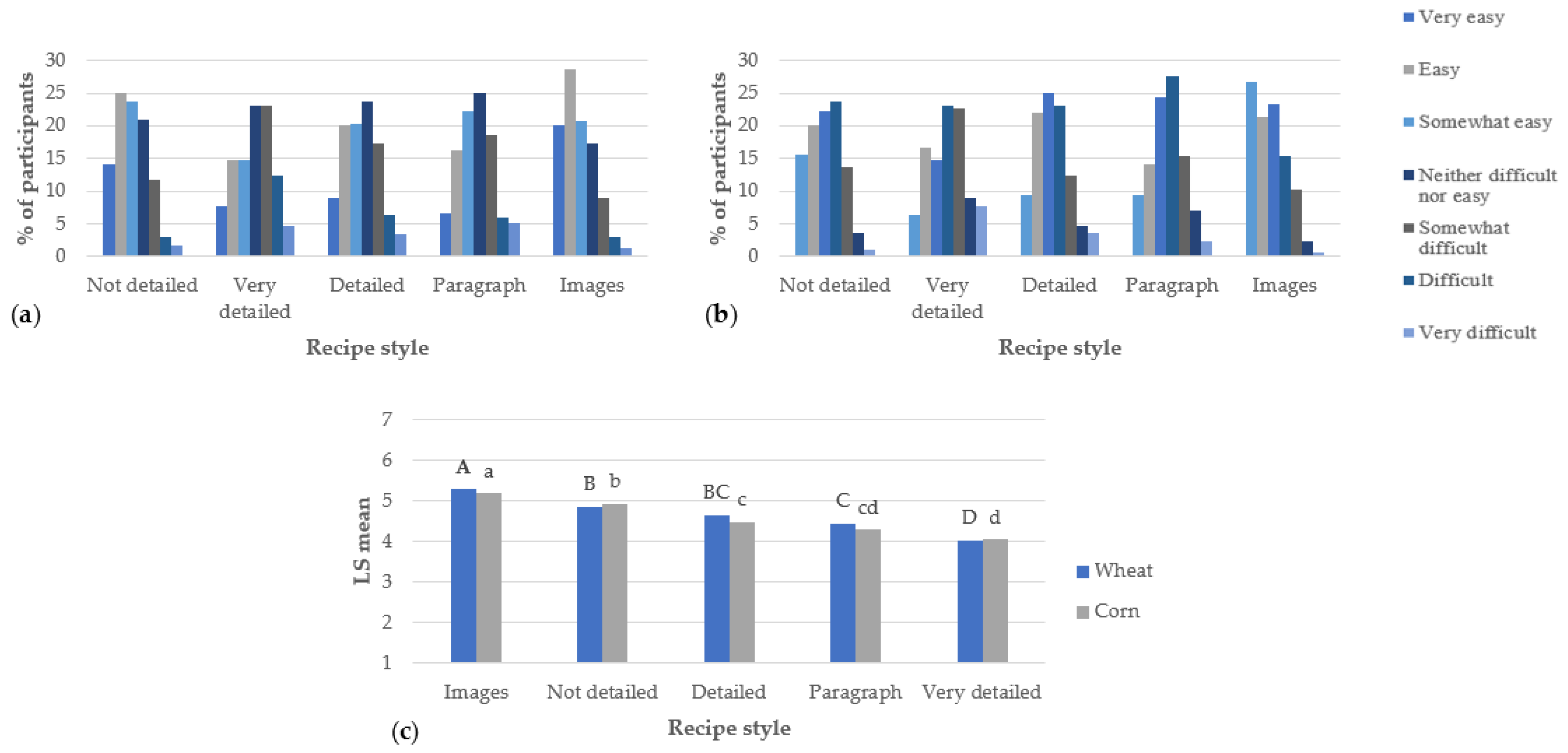
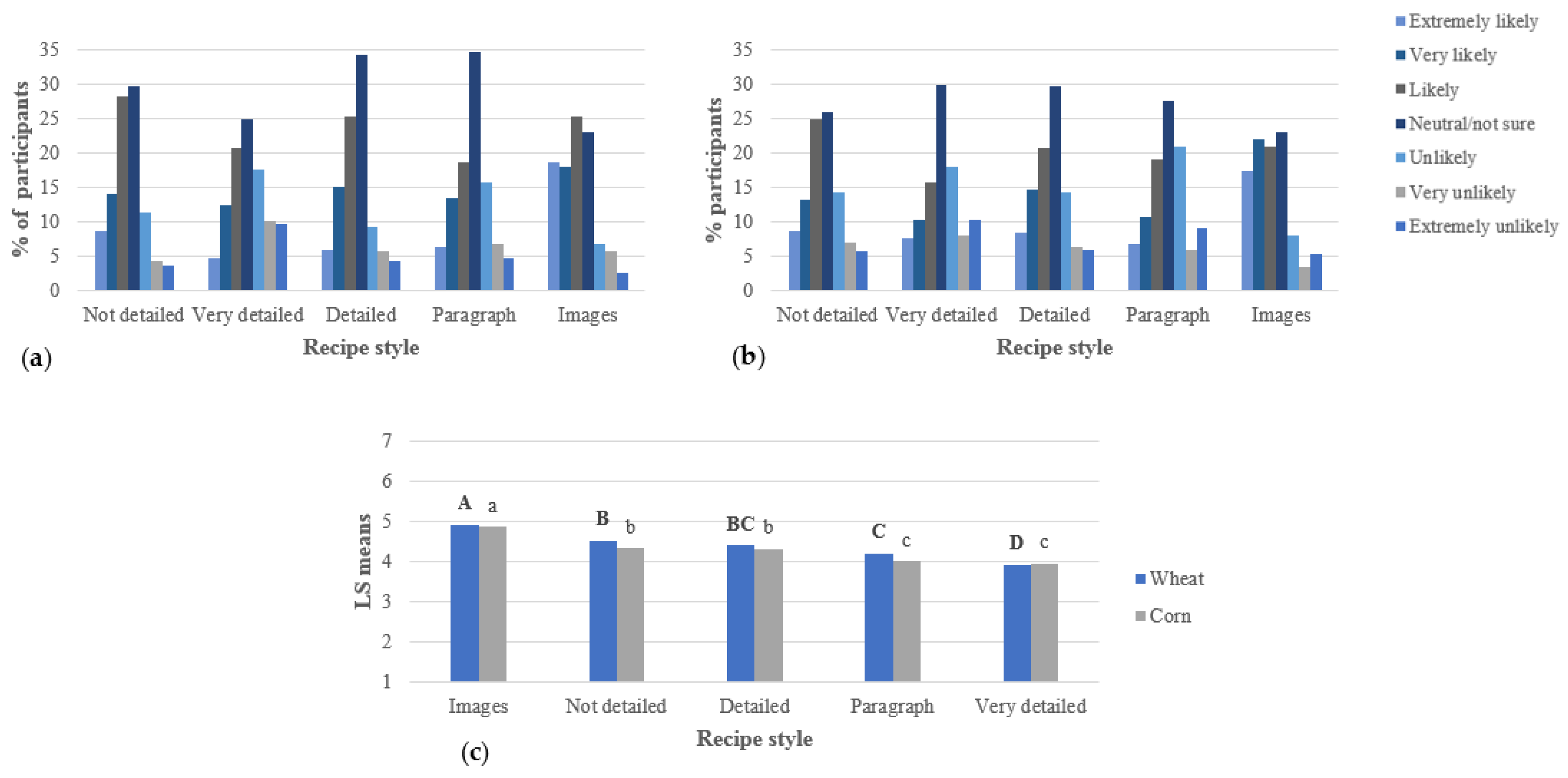
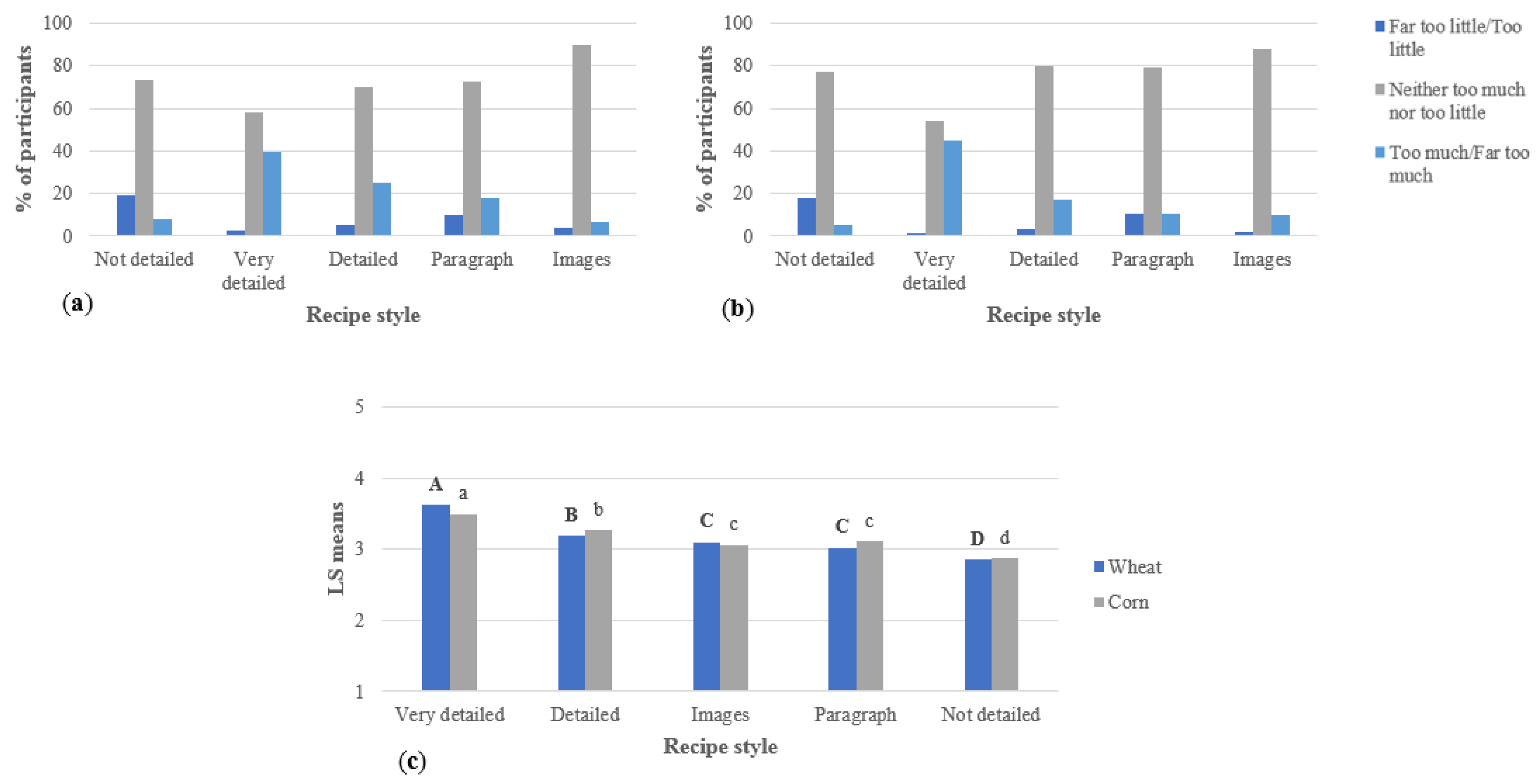
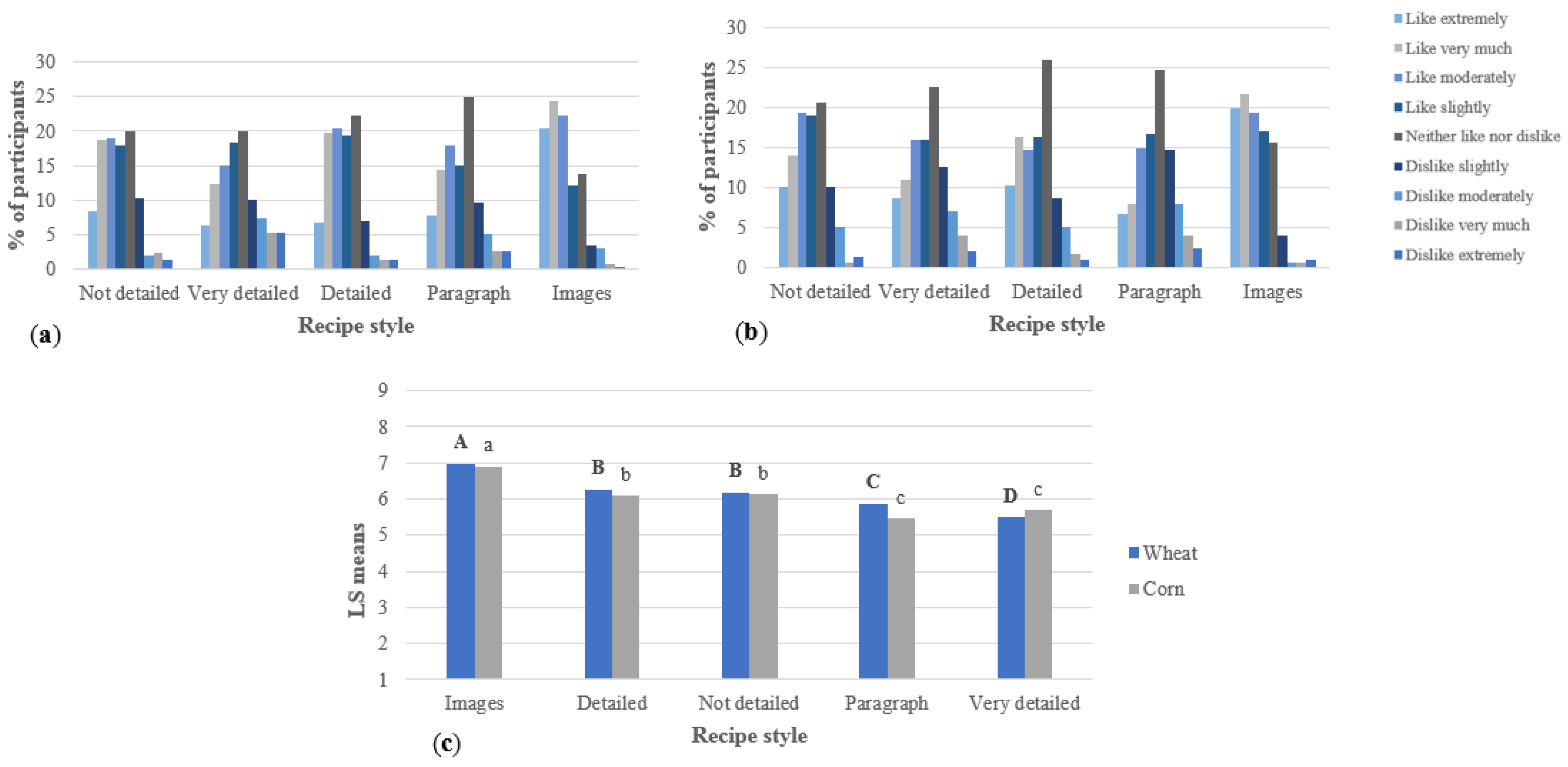


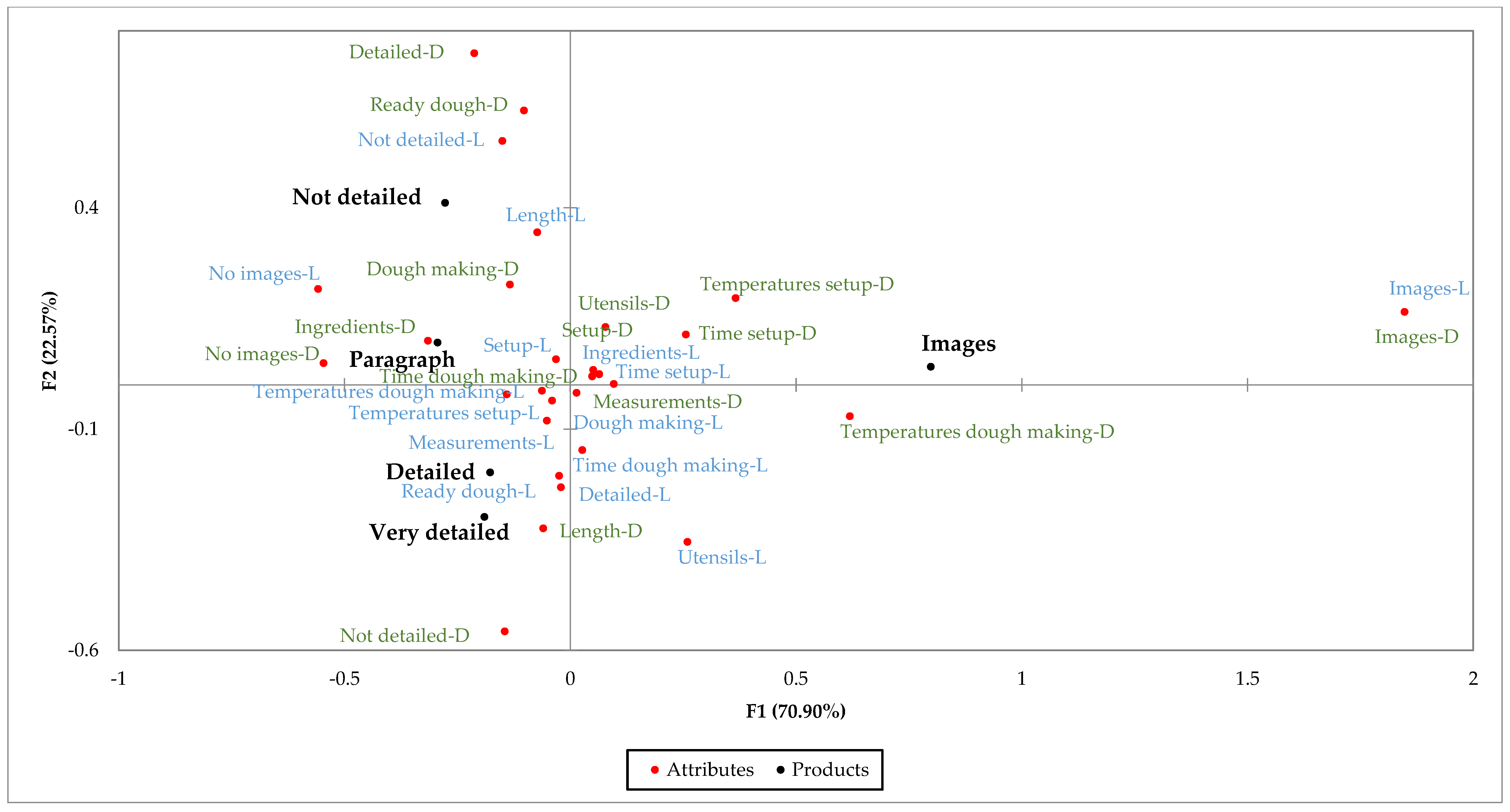
| Demographics | Wheat Study (%) | Corn Study (%) |
|---|---|---|
| Gender | ||
| Female | 79 | 100 |
| Male | 21 | 0 |
| Age (years) | ||
| 18–24 | 5 | 6 |
| 25–44 | 42 | 46 |
| 45–64 | 53 | 44 |
| 65 or older | 0 | 4 |
| Ingredient | Wheat (g) | Corn (g) |
|---|---|---|
| Flour | 500 | 400 |
| Water | 1000 | 500 |
| Salt | 70 | 50 |
| Instant yeast | 14 (approx., equivalent to 2 packets) | NA |
| Vegetable oil | 112 | NA |
| Demographics | Wheat Study (%) | Corn Study (%) |
|---|---|---|
| Gender | ||
| Female | 81 | 79 |
| Male | 19 | 21 |
| Age (years) | ||
| 18–24 | 7 | 8 |
| 25–34 | 12 | 14 |
| 35–44 | 17 | 13 |
| 45–54 | 19 | 19 |
| 55–64 | 21 | 24 |
| 65 or older | 24 | 22 |
| Ethnicity | ||
| White, not of Hispanic origin | 84 | 84 |
| Black, not of Hispanic origin | 7 | 8 |
| Asian or Pacific Islander | 4 | 2 |
| American Indian or Alaskan | 1 | 1 |
| Native Hispanic | 3 | 2 |
| Prefer not to answer | 2 | 3 |
| Wheat (%) | Corn (%) | |
|---|---|---|
| Measurement technique | ||
| Household/Volume | 86 | 18 |
| Weight | 5 | 2 |
| Household/Volume and Weight | 9 | 2 |
| Not measured ingredients | 84 | 88 |
| Did not measure flour during mixing | 7 | 80 |
| Did not measure flour during kneading | 67 | NA |
| Did not measure the water | 9 | 88 |
| Did not measure oil as an ingredient | 40 | NA |
| Did not measure oil to the bowl | 12 | NA |
| Did not measure the salt | NA | 82 |
| Ingredient | Wheat Dough | Corn Dough | ||||
|---|---|---|---|---|---|---|
| Average † (g) | Minimum (g) | Maximum (g) | Average † (g) | Minimum (g) | Maximum (g) | |
| Flour | 326 | 193 | 426 | 158 | 43 | 500 |
| Water | 251 | 191 | 378 | 229 | 52 | 649 |
| Salt | 7 | 2 | 36 | 6 | 0 | 52 |
| Yeast | 8 | 4.5 | 14 | NA | NA | NA |
| Oil | 25 | 0 | 112 | NA | NA | NA |
| Utensil | Wheat (%) | Corn (%) | ||
|---|---|---|---|---|
| Dry Ingredients | All (Wet and Dry) Ingredients | Dry Ingredients | All (Wet and Dry) Ingredients | |
| Wooden spoon | 44 | 65 | 0 | 0 |
| Metal spoon | 19 | 7 | 14 | 16 |
| Rubber spatula | 7 | 9 | 0 | 0 |
| Whisk | 2 | 0 | 0 | 0 |
| Fork | 0 | 0 | 0 | 2 |
| Hands | 5 | 7 | 16 | 96 |
| More than one utensil | 0 | 11 | 0 | 16 |
| Technique | Wheat (Frequency) | Corn (Frequency) | |||
|---|---|---|---|---|---|
| Dry Ingredients | All (Wet and Dry) Ingredients | Kneading | Dry Ingredients | All (Wet and Dry) Ingredients | |
| Stirring/Circular motions | 25 | 31 | NA | 12 | 31 |
| From the edges to the center | 9 | 4 | NA | 1 | 5 |
| Incorporating all together | 8 | 27 | NA | NA | 36 |
| Scraping the bowl | 2 | 25 | NA | 4 | 15 |
| Folding the mix or the dough | 5 | 12 | 36 | 2 | 19 |
| Well in the center | 13 | NA | NA | 1 | NA |
| Adding water, a little bit at a time | NA | 31 | NA | NA | 17 |
| Breaking lumps | NA | 7 | NA | NA | 8 |
| Adding flour when sticky/wet | NA | 12 | 23 | NA | 6 |
| Pressing/Pushing/Squeezing the dough | NA | 23 | 43 | NA | 50 |
| Timewise | NA | 2 | 5 | NA | NA |
| Rolling the dough | NA | NA | 12 | NA | NA |
| Quarter turn | NA | NA | 25 | NA | NA |
| Using the heel/palms of the hand | NA | NA | 19 | NA | NA |
| Flouring the surface | NA | NA | 38 | NA | NA |
| Too dry, needs more water | NA | 16 | NA | NA | 20 |
| Attribute | Wheat (Frequency) | Corn (Frequency) | |
|---|---|---|---|
| Dough after Mixing All the Ingredients | Ready Dough (after Kneading) | Ready Dough | |
| Sticky | 27 | 6 | NA |
| One ball/Does not fall apart | 25 | NA | 18 |
| Moist/Wet | 11 | 3 | 10 |
| Mixed in | 21 | NA | 12 |
| Pulls away from the sides of the bowl | 11 | NA | NA |
| Homogeneous/lump free | 10 | 9 | 20 |
| Hard to stir | 9 | NA | NA |
| Soft/Soft but not too soft | 7 | 19 | 17 |
| Not wet/Dry | 7 | 8 | 22 |
| Not-sticky | 4 | 30 | 39 |
| Elastic | NA | 32 | NA |
| Smooth | NA | 29 | 3 |
| Consistent | NA | 18 | NA |
| Pliable | NA | 16 | 16 |
| One-ball | NA | 14 | 7 |
| Not too hard/Firm | NA | 10 | 17 |
| Airy | NA | 10 | NA |
| Can handle with hand/workable | NA | 7 | 20 |
| Spongy | NA | 4 | NA |
| Rolls | NA | 3 | NA |
| Desired saltiness level | NA | NA | 35 |
© 2018 by the authors. Licensee MDPI, Basel, Switzerland. This article is an open access article distributed under the terms and conditions of the Creative Commons Attribution (CC BY) license (http://creativecommons.org/licenses/by/4.0/).
Share and Cite
Lezama-Solano, A.; Chambers, E., IV. Development and Validation of a Recipe Method for Doughs. Foods 2018, 7, 163. https://doi.org/10.3390/foods7100163
Lezama-Solano A, Chambers E IV. Development and Validation of a Recipe Method for Doughs. Foods. 2018; 7(10):163. https://doi.org/10.3390/foods7100163
Chicago/Turabian StyleLezama-Solano, Adriana, and Edgar Chambers, IV. 2018. "Development and Validation of a Recipe Method for Doughs" Foods 7, no. 10: 163. https://doi.org/10.3390/foods7100163
APA StyleLezama-Solano, A., & Chambers, E., IV. (2018). Development and Validation of a Recipe Method for Doughs. Foods, 7(10), 163. https://doi.org/10.3390/foods7100163





